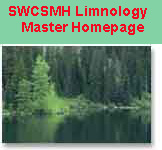Disclaimer & Copyright Notices; Optimized for the MS Internet Explorer
Family Chaoboridae
(Phantom midges)
Soil & Water Conservation Society of Metro Halifax (SWCSMH)
Updated: October 09, 2013 
![[Freshwater Benthic Ecology and Aquatic Entomology Homepage]](../../VIEW/ICON/homepage.gif)
Contents:
- Superphylum Arthropoda
- (jointed-legged metazoan animals [Gr, arthron = joint; pous = foot])
- Phylum Entoma
- Subphylum Uniramia
- (L, unus = one; ramus = branch, referring to the unbranched nature of the appendages)
- Superclass Hexapoda
- (Gr, hex = six, pous = foot)
- Class Insecta
- (L, insectum meaning cut into sections)
- Subclass Ptilota
- Infraclass Neopterygota
- Order Diptera
Introduction
In addition to the chironomid larvae, oligochaetes, and the small clam Pisidium, another major component of the profundal zone of lakes is the phantom midge Chaoborus. The larvae are called phantom larvae because of their transparency. They are unique in that their enlarged antennae have been modified for capturing prey such as insect larvae and small crustaceans. They are the only insects frequently found in the limnetic area of lakes. Adults do not feed, but their synchronized emergences may create severe nuisance problems around large lakes because adults are highly attracted to lights. Life cycles are univoltine to multivoltine, depending on species, climate, and habitat. Most larvae can be identified to species.
The life span of an adult phantom midge is very brief (<6 days). Eggs (about 500 in number) are laid on the water in rafts and most (97 per cent) hatch in two to four days. The larvae can develop to the fourth instar in six to eight weeks. The first and second instars are always limnetic and positively phototactic, and they develop rapidly in a few weeks. The third instar, mostly limnetic but also occurring in the sediments, is of much longer duration; the larvae can overwinter in this stage. After a variable period of up to several months, ecdysis to the fourth instar occurs; this instar is limnetic much of the time.
- The fourth instar of many species of Chaoborus undergoes strong diurnal vertical migrations. Migration does not occur as actively at temperatures below 5°C. Migration is influenced in part by oxygen tension of the water near the sediments. When the oxygen concentrations are high, most of the populations stay in the sediments; when there is less than 1 mg O2 l-1, they migrate to the surface during the night.
- Pupation takes from 1 to 2 weeks, and occurs from May to October in C. flavicans. The pupae migrate daily. Pupation and emergence as adults result in a reduction in the total benthic population during summer.
- In Lake Vechten (5 ha, 12 m) in The Netherlands, highest densities of larvae, 1,400 to 1,800 m-2 occurred in November. Annual net production of the benthic part of the population was estimated to be 8 to 12.5 kg (dry) ha-1 [70 to 90 kg wet weight ha-1 ] for C. flavicans in this lake.
Indicator value
In addition to the chironomid larvae, oligochaetes, and the small clam Pisidium, another major component of the profundal zone of lakes is the phantom midge Chaoborus.
References and web URLs:
- Narf, R. 1997. Midges, bugs, whirligigs and others: The distribution of insects in Lake "U-Name-It". Lakeline. N. Am. Lake Manage. Soc. 16-17, 57-62.
- Peckarsky, B.L., P.R. Fraissinet, M.A. Penton, and D.J. Conklin, Jr. 1990. Freshwater Macroinvertebrates of Northeastern North America. Cornell Univ. Press. xii, 442pp.
- Thorp, J.H., and A.P. Covich. 1991. Ecology and Classification of North American Freshwater Invertebrates. Academic Press, Inc. xii, 911pp.
- Wetzel, R.G. 1983. Limnology. 2nd ed. Saunders College Publishing. Xii, 767pp, R81,I10.
- Williams, D.D., and Feltmate, B.W. 1992. Aquatic Insects. CAB International. ISBN: 0-85198-782-6. xiii, 358p.
- Mandaville, S.M. 1999. Bioassessment of Freshwaters Using Benthic Macroinvertebrates-A Primer. First Ed. Project E-1, Soil & Water Conservation Society of Metro Halifax. viii, Chapters I-XXVII, Appendices A-D. 244p.
"Sounds provided by and copyrighted to Naturesongs.com, 1997-2004"


We salute the Chebucto Community Net (CCN) of Halifax, Nova Scotia, Canada for hosting our web site, and we applaud its volunteers for their devotion in making `CCN' the best community net in the world